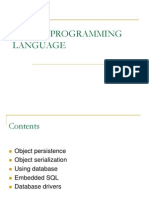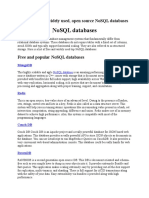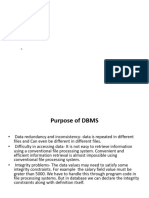0 ratings0% found this document useful (0 votes)
27 viewsOracle Database Architecture
An Oracle database allows for storage and retrieval of related data in a multi-user environment. It uses a database server to reliably manage large amounts of data while allowing concurrent access and delivering high performance. The database server also provides security and failure recovery capabilities. Oracle Database is designed for flexible and cost-effective enterprise grid computing using modular, industry-standard components that can be rapidly provisioned as needed. It separates logical and physical data structures so physical storage can be managed without affecting logical access.
Uploaded by
rajeshCopyright
© © All Rights Reserved
Available Formats
Download as DOCX, PDF, TXT or read online on Scribd
0 ratings0% found this document useful (0 votes)
27 viewsOracle Database Architecture
An Oracle database allows for storage and retrieval of related data in a multi-user environment. It uses a database server to reliably manage large amounts of data while allowing concurrent access and delivering high performance. The database server also provides security and failure recovery capabilities. Oracle Database is designed for flexible and cost-effective enterprise grid computing using modular, industry-standard components that can be rapidly provisioned as needed. It separates logical and physical data structures so physical storage can be managed without affecting logical access.
Uploaded by
rajeshCopyright
© © All Rights Reserved
Available Formats
Download as DOCX, PDF, TXT or read online on Scribd
You are on page 1/ 3
Oracle Database Architecture
An Oracle database is a collection of data treated as a unit. The purpose of a
database is to store and retrieve related information. A database server is the key
to solving the problems of information management. In general, a server reliably
manages a large amount of data in a multiuser environment so that many users
can concurrently access the same data. All this is accomplished while delivering
high performance. A database server also prevents unauthorized access and
provides efficient solutions for failure recovery.
Oracle Database is the first database designed for enterprise grid computing, the
most flexible and cost effective way to manage information and applications.
Enterprise grid computing creates large pools of industry-standard, modular
storage and servers. With this architecture, each new system can be rapidly
provisioned from the pool of components. There is no need for peak workloads,
because capacity can be easily added or reallocated from the resource pools as
needed.
The database has logical structures and physical structures. Because the
physical and logical structures are separate, the physical storage of data can be
managed without affecting the access to logical storage structures
n computing, ODBC (Open Database Connectivity) is a standard programming
language middleware API for accessing database management
systems (DBMS). The designers of ODBC aimed to make it independent of
database systems and operating systems. An application written using ODBC
can be ported to other platforms, both on the client and server side, with few
changes to the data access code.
ODBC accomplishes DBMS independence by using an ODBC driver as a
translation layer between the application and the DBMS. The application uses
ODBC functions through an ODBC driver manager with which it is linked, and
the driver passes the query to the DBMS. An ODBC driver can be thought of as
analogous to a printer driver or other driver, providing a standard set of functions
for the application to use, and implementing DBMS-specific functionality. An
application that can use ODBC is referred to as "ODBC-compliant". Any ODBCcompliant application can access any DBMS for which a driver is installed.
Drivers exist for all major DBMSs, many other data sources like address
booksystems and Microsoft Excel, and even for text or CSV files
You might also like
- IM Ch15 DB Connectivity Web Technologies Ed12No ratings yetIM Ch15 DB Connectivity Web Technologies Ed1226 pages
- Name: Department: Roll No: Subject: Submitted To:: Araiz Mirza Bs (It) 082 Data-Base Sir SayyamNo ratings yetName: Department: Roll No: Subject: Submitted To:: Araiz Mirza Bs (It) 082 Data-Base Sir Sayyam4 pages
- 14 Database Management With Microsoft ODBCNo ratings yet14 Database Management With Microsoft ODBC13 pages
- Name: Rohaan Abdul Rauf STD ID: BSE-20F-096 Semester: 4A Course: MIS (Management Information System) Assignment: 2No ratings yetName: Rohaan Abdul Rauf STD ID: BSE-20F-096 Semester: 4A Course: MIS (Management Information System) Assignment: 25 pages
- Primavera Software Development Kit ProgrammerNo ratings yetPrimavera Software Development Kit Programmer30 pages
- Object-Oriented Database: Adoption of Object DatabasesNo ratings yetObject-Oriented Database: Adoption of Object Databases5 pages
- Cloud Migration of Oracle Analytical DB (On-Premise) To AWS RedshiftNo ratings yetCloud Migration of Oracle Analytical DB (On-Premise) To AWS Redshift10 pages
- Top 18 Free and Widely Used, Open Source NoSQL DatabasesNo ratings yetTop 18 Free and Widely Used, Open Source NoSQL Databases4 pages
- SQL Demystified: A Beginner's Roadmap to Data Retrieval and ManagementFrom EverandSQL Demystified: A Beginner's Roadmap to Data Retrieval and ManagementNo ratings yet



























































